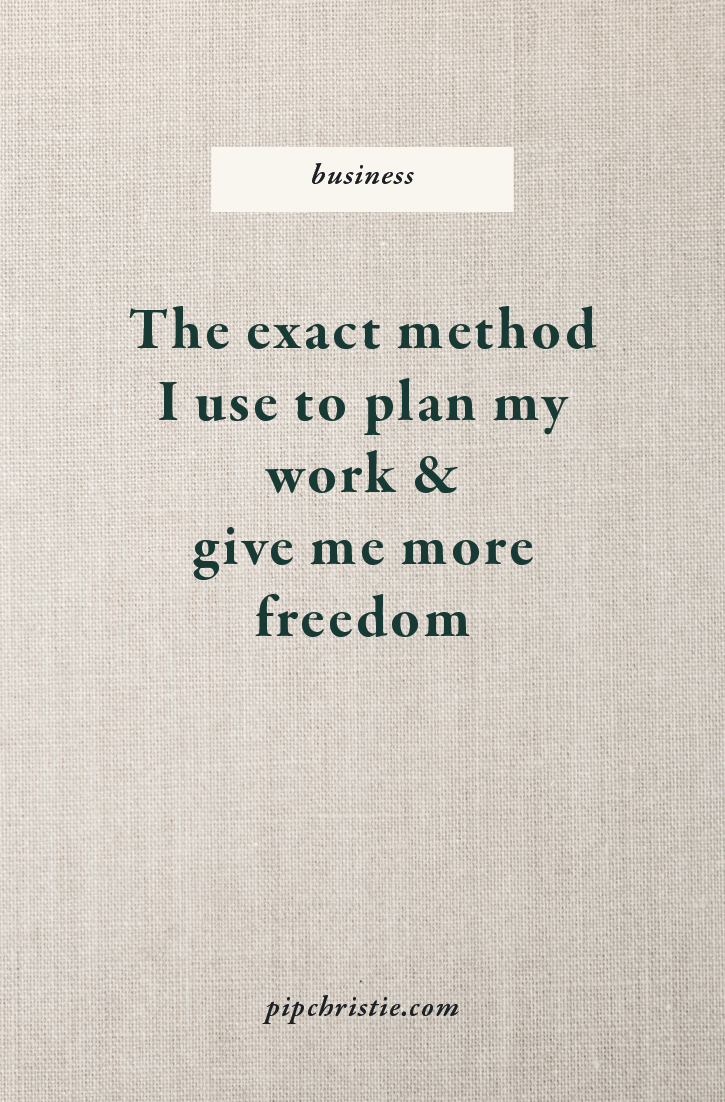The exact method I use to plan my work
There was a common phrase in my household growing up.
One that you’d hear each time a new idea was being hashed out over the breakfast table.
One that’d be the first piece of advice every time I’d decide to alter my path and go off piste.
And one that, as a teenager, I never quite understood. “Just make a plan.”

Why was planning such a big thing? It felt so restrictive, so prescriptive and so…boring. Teenage me would rebel against it, far preferring to make things up as I went. Planning felt far too predictable for all the adventures I was dreaming of. Fast forward 15 years? Now it’s planning that gives me freedom. It’s planning that gives my brain the space it needs to be creative, and my body the time to actually go on those adventures.
Ah, isn’t joyous when you realise your parents were right all along?!
*oops*
But, for the most part, planning my working weeks (and months) enables me to show up for my own business in the same way I do for my clients’.
Because this isn’t about just getting the job done today, it’s about making sure that I do the best job possible, every single day, long into the future.
Before you start to plan, get it all out on paper
Although I set a quarterly outlook for the internal activities of my business, the nitty gritty stuff happens month by month. I’ll plan out each month, and then break that down week by week.
But before I can start to plan, I need to get it all out on paper. I start with the essentials, jotting down what’s booked in and what commitments I have coming up. Mostly, that means reviewing copywriting projects, looking for any interview commitments or external writing pieces and getting them all jotted down.
After I’ve listed out all the essentials, then I’ll assess what else I’d like to get done. This means reviewing my strategy work, adding in space for my regular content planning and content creation, planning time to schedule my social media activities, and any other marketing pieces I have coming up.
Then, I streamline it. I’m always a tad overzealous. I’m a bit like that excited kid at the buffet table, piling my plate so high that it’s at risk of toppling over before I’ve even gotten back to my seat. So, out comes the red pen to cut it all down. If anything takes less time than anticipated, I have that master list ready to dive into should the need arise.
I’d actually recommend aiming for less over more here. Assume that things will take you longer than you expect, and weave some ‘break time’ into your calendar. Life happens, unexpected hurdles pop-up and some days you’re just not going to be feeling it. I don’t believe in ‘powering through’ those moments. Rather, close that laptop lid, stop upping your caffeine intake (yes I really did say that) and step outside instead.
Some people also like to set top three goals for each month, with the mini-list representing your top priorities for the 30 days ahead. If that sounds like something that’d work well for you, now’s the time to give it a go.
Break out each project into planned tasks
Just like in the SMART goal methodology, your monthly plan needs to be specific and measurable. There’s no point putting something into your plan only to get to the end of the month to not even know whether or not you’ve achieved it. That’d feel a bit miserable!
So, I break down each project into actionable steps and add these into my Trello board. Each project has its own card, with its own list of actions. These are then arranged into two columns that form my plan for the month: one column for client work and one column for my own ‘on the business’ work.
I’ll then add in any key deadline dates and order each project by priority.
Plan for your recurring activities
When you run a small business, there are going to be activities that you have to do each and every week or month. Whether it’s admin, marketing, accounting or content creation, there’s always something that needs to be done.
Rather than writing these out each week, I like to create recurring lists that I can refer back to time after time again. Not only does this help me to plan for the right time allowances but it also enables me to add batch days to my monthly plan. Take this blog post for example. I’m not writing it on publication day – it was written in advance, alongside all my other blog posts for this month, on my batch content days.
I love organising key activities together like this. I feel at ease knowing that I have the time already set in my plan to get it all done, and can get totally in the zone with good music, a strong cup of coffee and a quiet space to focus on my work and fly through my list.
Dissect your monthly plan, week by week
Every Friday morning, I sit down to plan the week to come. I’ll review what I’ve gotten done over the past five days, note down any unexpected projects or additional requests that have come through, and use my monthly plan to create my priority list for next Monday.
If you heard my interview on the Modern Day Rebels podcast, you’ll know that I like to segment my days into different themes. On the whole, Mondays and Fridays are my ‘working on the business’ days, and Tuesday to Thursday are my ‘working in the business’ days aka client work days.
I never take client calls on Monday and Fridays. Instead, these are my days for inner work, behind the scenes projects, my own marketing and, of course, content creation. Sometimes there’s a little overspill with client work creeping through but I find that these days work nicely as a buffer to ensure that everything’s done in plenty of time (I am the girl that handed in her dissertation five days early after all, I’ve never missed a deadline!).
All this planning means that, by the time Monday morning rolls around, I’m primed and ready to go. I know what needs to be done and never have that sinking Sunday night feeling where you wonder what on earth you need to get through next week and how you’re going to do it all. No thank you, life’s too short for that.
Write your website copy like a pro copywriter (without the pro price tag)
Introducing... the about page roadmap.
You’ll get access to the same copywriting framework I use with my small business clients. So you can have an about page that feels 100% you.




I am such a bad planner, oh dear, but I am a work in progress and your tips are great thank you xx
You’re so welcome Teresa – glad they resonated! It’s all about finding an approach that works for you, whatever that may look like 🙂